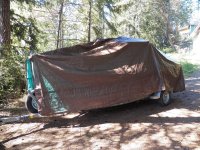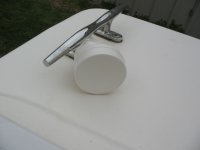Scott Fletcher":16zg9izj said:
When you screwed your furniture back down how did you ensure you screws into the middle of your epoxy plug?
Each of my screw holes were drilled out with a 1/2 inch drill. Then the holes were undercut, so the amount of balsa removed was about a 1 inch circle. I then put in penetrating epoxy to seal the exposed balsa. Smith brand penetrating epoxy doesn't cure with an amine blush, so my epoxy putty would bond to it.
My epoxy "putty" was the consistency of honey. I drizzled it into the holes and then returned with more putty a few times as bubbles came to the surface. I had a few areas where the volume was bigger than a 1 inch circle, and I did those in several "lifts," meaning that I would put in a 1/3 of an inch, let the putty cure and throw off some heat, and then add another layer. Reason being that if you cure too much epoxy at one time the heat generated can cause the putty to foam up.
Even though the holes were filled to the point of making a little dome of putty above the hole, the epoxy shrinks as it cures and would end up leaving a little divot or dimple. I didn't worry about that because the panel would eventually cover the holes. Plus, having some of the holes with dimples in the center made it easy to see exactly the center of the putty repair (even when painted, which I did before the reinstall) and I knew exactly where to drill my screw holes.
I had several paper cups with left over epoxy putty in them, so I drilled them for screw holding tests. I used micro-balloons instead of cabosil. MB traps more heat when curing, but my experience is that it is more forgiving when driving screws and still has sufficient screw holding ability. It is more like driving a screw into wood, where the wood can crush rather than split if the hole isn't perfect. Even still, I put a drop of penetrating epoxy on the screw just in case something went wrong (split the epoxy plug or the screw hole went outside the epoxy plug). That last part was kind of tedious, but after all that work I didn't want any possibility of exposed balsa. I secured the panel in place using the several pre-drilled screw holes for each panel. Once I was satisfied that the panel was sitting exactly in the same spot as when removed, I drilled the rest of the holes using the panel as a template. I watched and made sure that none of the swarf had any balsa in it.
I didn't use any panel-to-deck caulking for the re-install because I wanted the water that gets behind the panels to drain out. Whatever the original caulking was, it had failed (which may have allowed the rivets to work open and allow more water into the core). I just couldn't see that recaulking would do anything. It certainly hadn't done anything for the original construction technique.
Your boat is going to be subjected to the famous C Dory pounding when in choppy seas and I'm not sure that I would have confidence with just caulking, even 3M 5200. One reason would be that the deck is painted. Assuming you can clean off the bottom of the panel and get a good bonding surface for 5200, on the deck the 5200 would be attached to the old paint. That means that ultimately your panel (holding a 200# passenger in a pounding sea) is held in place by a layer of paint. I would want some mechanical fasteners.
A couple of my upper screws that hold the front of the panel to the side deck had failed, as yours apparently did in the past. There wasn't enough material for the screws to bite into. I used some disposable eye droppers, made some honey putty, and injected that into the holes, placing a piece of tape over the holes so that it couldn't drool out when curing. I had to put several droppers full in a couple of holes, so I don't really know what is inside there, if anything. Anyway, I ended up with an epoxy plug that I drilled and refit the original screws. The boat has been through several rigorous poundings (the honeymoon is over) and all is well.
One of the reasons that I didn't use any caulking is because it is
possible that I will need access because of my heater install on the passenger side. The thought of removal is daunting enough without having the panel also glued in place.
Mark




